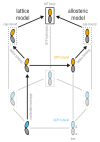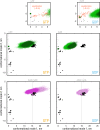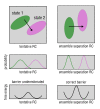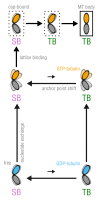Microtubule assembly governed by tubulin allosteric gain in flexibility and lattice induced fit
- PMID: 29652248
- PMCID: PMC5945277
- DOI: 10.7554/eLife.34353
Microtubule assembly governed by tubulin allosteric gain in flexibility and lattice induced fit
Abstract
Microtubules (MTs) are key components of the cytoskeleton and play a central role in cell division and development. MT assembly is known to be associated with a structural change in [Formula: see text]-tubulin dimers from kinked to straight conformations. How GTP binding renders individual dimers polymerization-competent, however, is still unclear. Here, we have characterized the conformational dynamics and energetics of unassembled tubulin using atomistic molecular dynamics and free energy calculations. Contrary to existing allosteric and lattice models, we find that GTP-tubulin favors a broad range of almost isoenergetic curvatures, whereas GDP-tubulin has a much lower bending flexibility. Moreover, irrespective of the bound nucleotide and curvature, two conformational states exist differing in location of the anchor point connecting the monomers that affects tubulin bending, with one state being strongly favored in solution. Our findings suggest a new combined model in which MTs incorporate and stabilize flexible GTP-dimers with a specific anchor point state.
Keywords: dynamic instability; microtubule; molecular biophysics; molecular dynamics; none; structural biology; tubulin.
© 2018, Igaev et al.
Conflict of interest statement
MI, HG No competing interests declared
Figures















Similar articles
-
Intrinsic bending of microtubule protofilaments.Structure. 2011 Mar 9;19(3):409-17. doi: 10.1016/j.str.2010.12.020. Structure. 2011. PMID: 21397191
-
Structural mass spectrometry of the alpha beta-tubulin dimer supports a revised model of microtubule assembly.Biochemistry. 2009 Jun 9;48(22):4858-70. doi: 10.1021/bi900200q. Biochemistry. 2009. PMID: 19388626 Free PMC article.
-
The free energy profile of tubulin straight-bent conformational changes, with implications for microtubule assembly and drug discovery.PLoS Comput Biol. 2014 Feb 6;10(2):e1003464. doi: 10.1371/journal.pcbi.1003464. eCollection 2014 Feb. PLoS Comput Biol. 2014. PMID: 24516374 Free PMC article.
-
Tubulin rings: which way do they curve?Curr Opin Struct Biol. 2003 Apr;13(2):256-61. doi: 10.1016/s0959-440x(03)00029-0. Curr Opin Struct Biol. 2003. PMID: 12727521 Review.
-
Structural switching of tubulin in the microtubule lattice.Biochem Soc Trans. 2025 Feb 5;53(1):BST20240360. doi: 10.1042/BST20240360. Biochem Soc Trans. 2025. PMID: 39910801 Free PMC article. Review.
Cited by
-
Wordom update 2: A user-friendly program for the analysis of molecular structures and conformational ensembles.Comput Struct Biotechnol J. 2023 Jan 27;21:1390-1402. doi: 10.1016/j.csbj.2023.01.026. eCollection 2023. Comput Struct Biotechnol J. 2023. PMID: 36817953 Free PMC article.
-
Effect of Colchicine Binding Site Inhibitors on the Tubulin Intersubunit Interaction.ACS Omega. 2023 Aug 3;8(32):29448-29454. doi: 10.1021/acsomega.3c02979. eCollection 2023 Aug 15. ACS Omega. 2023. PMID: 37599936 Free PMC article.
-
XMAP215 promotes microtubule catastrophe by disrupting the growing microtubule end.J Cell Biol. 2021 Oct 4;220(10):e202012144. doi: 10.1083/jcb.202012144. Epub 2021 Jul 29. J Cell Biol. 2021. PMID: 34324632 Free PMC article.
-
Mechanical properties of tubulin intra- and inter-dimer interfaces and their implications for microtubule dynamic instability.PLoS Comput Biol. 2019 Aug 30;15(8):e1007327. doi: 10.1371/journal.pcbi.1007327. eCollection 2019 Aug. PLoS Comput Biol. 2019. PMID: 31469822 Free PMC article.
-
Structural insights into the mechanism of GTP initiation of microtubule assembly.Nat Commun. 2023 Sep 25;14(1):5980. doi: 10.1038/s41467-023-41615-w. Nat Commun. 2023. PMID: 37749104 Free PMC article.
References
Publication types
MeSH terms
Substances
LinkOut - more resources
Full Text Sources
Other Literature Sources

